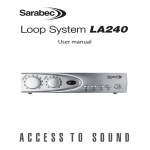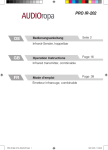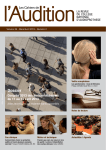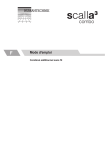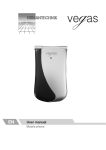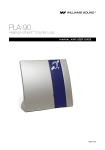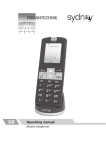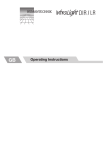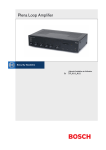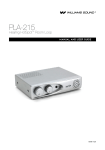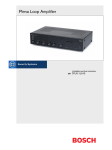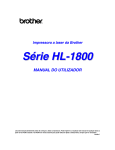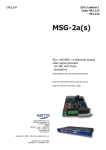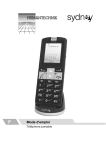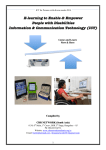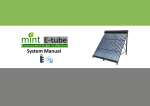Download A-4221-0 : LA-240
Transcript
EN User manual Loop system LA-240 Introduction The LA-240 Loop System provides a practical solution for hearing aid users to listen more easily to their TV or Audio equipment via the “T” or “Loop” facility of their hearing aid. With no direct connection between the user and a TV or Audio equipment the user is able to move freely within the looped area and listen comfortably to a TV or audio equipment without the distractions of normal listening. The Loop System is used in conjunction with a hearing aid with a “T” or “Loop” function found on many ‘behind the ear’ or ‘in the ear’ hearing aids. The Loop system picks up the sound from a TV via a microphone or direct connection and feeds it to the amplifier. The sound is then passed to a loop of wire around the listening area, which in turn transmits the sound inductively, “magnetic sound waves”, to a hearing aid with the loop facility. The user may then adjust the loop volume or tone to suit their own hearing preference without affecting others. The Loop System is supplied with a loop cable. The loop cable is placed around a room that you want to listen in. The sound can be heard anywhere inside the “looped” area and sometimes just outside the loop as well. A loop pad (available as accessory) is an alternative to a loop cable and can be used to create a localised or portable system to avoid interference with other systems or where confidentiality is required. Quick Setup 1. Check contents of package. 2. Place amplifier near TV or Audio equipment with or without stand. 3. Connect audio leads between TV or Audio system and Loop Amplifier. 4. Place loop cable around room and connect both ends of wire to the loop cable connectors on the rear of the loop amplifier. 5. Plug the power supply unit lead into the amplifier. Connect the mains lead to the power supply unit and place the mains plug into a convenient mains socket 6. Switch on TV / Audio equipment and Loop Amplifier. 7. Switch hearing aid to “T” or Loop function 8. Adjust loop amplifier volume/tone to suit listening level. 2 Important Safety Instructions The manufacturer cannot be held responsible for damage which is caused by not using this Loop System in compliance with these safety instructions. IF IN ANY DOUBT SEEK EXPERT ADVICE 1. Read and follow these instructions taking note of any warnings. 2. Keep these instructions for future reference. 3. Do not use the system or accessories near water. 4. Do not expose the system or accessories to rain or any other source of moisture. 5. Should the amplifier require cleaning only do so with a dry cloth. 6. Ensure that there is enough room around the Loop Amplifier for ventilation purposes. 7. Do not cover the ventilation holes of the amplifier with anything. 8. Do not place the Loop Amplifier close to sources of heat, such as radiators. 9. Place all connecting and power leads such that they are not a hazard or where they may become damaged. 10. Do not open casing of Loop Amplifier at any time; there are NO user serviceable parts. 11. Servicing must be referred to qualified service personnel. CAUTION: Ensure mains power is disconnected BEFORE any audio connections are made to the Loop Amplifier. To completely disconnect the system from the mains, remove the mains plug from the wall socket. CAUTION: The top surface of the amplifier may become hot when operating this system continuously. Do not touch the top surface during use or block the ventilation holes. 3 Product Overview VO LU An enhanced microprocessor controlled loop amplifier with outstanding sound quality designed to be used with modern audio and video products to transmit the sound direct to your hearing aid. Your hearing aid must be switched to the “T” or Loop function to use the loop system. You can also enjoy the benefits of the loop amplifier by simply plugging a set of headphones into the headphone socket on the rear of the amplifier. For best results connect the amplifier directly to your TV or other sound source using the lead kit supplied. E M 1 2 1) Volume Control 2) Tone Control 3) Loop level indicator ! 3 4 5 6 7 8 4) Microphone input select 5) Line input A select 6) Line Input B select # 10) DC power socket 11) Loop cable connectors 12) Headphone socket 19) Microphone Input B $ % &( 13) Digital audio coaxial 14) Digital audio optical 15) Line Input B 7) Digital Audio input select 8) Power On/Standby ) *+ , 16) Line Input A 17) Microphone Priority 18) Microphone Input A IMPORTANT Always disconnect from mains supply before making any connections! 4 Setting Up • The loop system is supplied ready for use with the following items • Loop Amplifier with stand. • Power Supply with lead and Mains lead with fitted plug. • Digital audio optical TOSlink lead. • Analogue audio lead kit : 1.2m phono – phono lead, SCART to RCA adaptor and 3.5mm stereo jack to RCA adaptor. • 40m(130ft) Loop Cable and pack of 50 cable clips • Guarantee Card • User manual Loop Amplifier Place the amplifier in a convenient well ventilated area near to the TV or other audio source such that all necessary connection leads can reach the relevant device. The optional stand may be used to mount the amplifier vertically if required.. Place Loop Cable around listening area Run the loop cable around the room starting and ending at the amplifier. The cable may be tucked under the edge of the carpet, or fixed to either a picture / dado rail or skirting board with the clips provided. Where the cable passes a door or other obstacle, either fix the cable around the frame or tuck under the carpet. The cable only has to go round the area to be looped, it does not matter about going up and over doors/windows or round fireplaces etc. Excess loop wire may be cut off, provided a MINIMUM of 11 metres (35 feet) is left connected to the amplifier. DO NOT leave spare cable coiled on the drum. If using a Loop Pad Place the loop pad (available as accessory) in a suitable position on the chair to be used for listening, either on the chair back or under the seating area. Lay the connecting lead from the Pad to the back of the Amplifier. Make sure that the connecting lead is kept out of the way to prevent injury or obstruction. 5 Connect Loop Cable or Loop Pad to the amplifier When the loop cable connector (11) buttons are pushed in a hole will appear. Push the bare wire into the hole. Ensure that only the bare wire and not the plastic insulation goes into the hole, then release the button to lock the cable in place. Connect Audio Inputs from TV or other Audio Source to Loop Amplifier Direct audio connections This is the preferred method of connecting your amplifier to TV and other audio products. It will deliver the clearest sound to you without background noise affecting the clarity. This amplifier is fitted with digital and analogue audio inputs. Digital Optical TOSlink and Coaxial outputs are found on most current TVs and Audio equipment. These connections (13) & (14) will provide the clearest sound input to your system. Analogue audio connections use the red/white phono audio connectors (15) & (16) on the loop amplifier. Analogue audio is widely found on all types of equipment. Up to 3 pieces of equipment may be directly connected to the loop amplifier at any one time. One digital using either TOSlink or Coaxial but NOT both at the same time and one or two pieces of equipment with analogue audio output. If the TV or other sound source does not have a set of phono connectors then use the SCART or jack adaptors accordingly to connect the equipment. If you use the jack adaptor you may find that when plugging into a headphone socket on your TV etc., this turns off the internal speaker. On some TVs there may be a switch that allows the TV speaker to be left on. Microphones If a direct connection is not possible then a microphone can be used to pick up the sound from a TV or other loudspeaker. Microphones can also be used for someone to speak directly into the loop system so they can speak directly to the hearing aid user while they listen to TV. A microphone can be used at the same time as the line inputs to monitor environmental sounds such as a doorbell or telephone bell. A microphone can also be used in either a classroom or other public speaking situations. One or two microphones can be used at the same time using sockets (18) & (19). A priority function also exists when using a microphone in channel B (19) to override sounds from any other input to the loop amplifier. 6 Power Plug the power supply lead into the socket (10) on the rear of the amplifier. Connect the mains lead to the power supply and then plug into a mains outlet. Switch on the power at the outlet. This amplifier may also be used with DC power supplies directly connected to the amplifier such as those found in buses and coaches. Operation When connecting power for the first time to your amplifier the power button (8) will illuminate blue and the amplifier will be “On”. This is normal operation and is useful where remote switching of the system is required such as in buses and coaches. Pressing the power button will change the colour to red and the amplifier will be in the standby mode which uses low power and no signal will be passed to the loop. In order to remove all power from the unit the power supply must be disconnected from the amplifier and the mains outlet. Press the button power again and it will light up blue. The system is now ready for use. • Set the television or other audio equipment to the normal listening level for other members of your household. • Select the sound source required from the buttons (4) - (7). • Set the volume control to minimum. • Set the tone control to the normal position (12 o’clock). • Switch your hearing aid to the ‘T’ or loop function. • Adjust the volume and tone to suit your listening. Pressing the power button will turn the amplifier off and the light will go red. The next time the power is turned on the volume, tone and source selections from the previous session will be restored. Volume control (1) Use to adjust the volume of the signal received by the hearing aid. As the signal increases the blue light will travel around the control indicating the volume in use. Tone control (2) Use to vary the tone of the signal. Turned in the clockwise direction the higher frequencies will be emphasised and in the anti-clockwise direction the lower frequencies will be emphasised. 7 As the tone control is moved the blue light will travel around the control indicating the tone position in use. Loop level Indicator (3) This indicates that a signal is being transmitted by the loop cable. It flickers with a low volume and remains steady with louder volumes. Testing the system can be done by speaking into a microphone and seeing the light flash, this will indicate that a signal is flowing round the cable. Sound source selections (4-7) Pressing one of these buttons will select the sound source connected to the amplifier in the corresponding sockets 13-19 on the rear of the amplifier. One or more of these can be selected at any one time. When the channel is selected a blue light will show in the button. Pressing again and the light will go out showing that channel is off. Microphone (4) Selecting this will allow sound from microphones connected to sockets (18) and/or (19). If a microphone is plugged into socket B (19) then if the priority button (17) is pushed in any sound received by this microphone will override all the other sounds connected to the loop system. This can be useful when used to monitor a doorbell or telephone bell or if a partner wants to talk to the hearing aid wearer through the loop. Analogue Line Input A (5) and Analogue Line Input B (6) Wählt die jeweiligen eingehenden Signale von Kanal A (16) oder B (15) an. Dient zur Auswahl von z. B. Fernseher oder DVD-Player, sodass die Auswahl des jeweiligen Gerätes bequem von der Vorderseite des Verstärkers getätigt werden kann. Es können beide Kanäle gleichzeitig ausgewählt werden. Digital Audio (7) Allows the selection of the line input signals from channel A (16) or B (15). Useful to connect to a TV and DVD player so that either may be simply selected from the front panel. Either or both channels may be selected simultaneously. Headphone socket (12) The Headphone socket may be used with headphones that have a stereo 3.5mm plug fitted. This may be used by a non-hearing aid user to receive amplified sound. It can also be used to test that the loop system is set up correctly. Headphones used in this way will not affect the performance of the loop system for hearing aid users. The headphone socket may be used without a loop cable being connected but the loop level indicator will not show. 8 Remote Control The remote control allows the user to operate all the front panel controls of the amplifier previously described with the addition of a mute function for the volume. 9 Problems and Cures Symptom No sound Possible cause and remedy • Re check all connections. • Amplifier not switched on. Switch on at mains socket. Press mains switch. Check blue light is on. • Microphone or audio source not connected or selected. • Hearing aid not on the ”T” or loop program. Low sound Distorted sound • • • • Microphone too far from sound. Loop cable wired incorrectly. Volume control set too low. Increase volume. TV or audio volume set too low. Increase volume. • Volume control set too high. Loop level indicator showing permanently. Decrease volume. • TV/ Audio volume set too high. • Move microphone away from loud speaker. • Microphone Plug/lead damaged. Background noise (hum or buzz) • If noise remains when loop amplifier is turned off but hearing aid is still on loop program this interference caused by other equipment such as fluorescent lights or dimmer switches. With the loop amplifier turned off and the hearing aid still on the loop programs turn items off and on until the interference can be identified. • If noise stops when the loop amplifier is turned off there may be a fault in th esystem or microphjione lead or noise is being picked up by the microphone. 10 Specifications Power Supply Controls Input connections • • • • • • 18V 1.5A Power Supply Rotary Volume Control Rotary Tone control On/Off power switch Source selector switches Priority switch • Digital Audio TOSlink/Coaxial • 2 x Microphone inputs. 3.5mm mono jack plug. DC powered 5V for electret microphones • 2x Aux In Left/Right line inputs. Phono/RCA sockets. For direct connection to a TV sound output or other audio source via SCART or other suitable socket. Output connections • Push grip connectors for loop cable or loop pad (Labelled: Loop Cable). Loop will give full output with loop resistance between 0.5 and 1.5 Ohms.3,5mm • 3.5mm stereo jack for headphones (Phones) 8-60 Ohms Loop output • 3.0A output current @ 100-5KHz. Meets BS EN60118-4:2006 for a loop not exceeding 6.5m (20ft) in width . Suitbale for areas up to 70m2 Loop cable • Single turn loop cable. System supplied with 40m (130ft) 24/0.2mm (0.75mm2) single core PVC insulated cable. Min cable length 11m = 0.5 Ohms Indicators • Blue/Red LEDs Humantechnik GmbH and Sarabec Ltd declare that the LA-240 complies with all relevant EU directives. The full EU declaration of conformance for the LA-240 is available on www.humantechnik.com and www.audioropa.com 11 Humantechnik Service-Partner D Germany CH Switzerland F/B France Belgium AU Australia IL Israel Humantechnik GmbH Im Wörth 25 D-79576 Weil am Rhein Tel.: +49 (0) 76 21/ 9 56 89-0 Fax: +49 (0) 76 21/ 9 56 89-70 E-mail:[email protected] Humantechnik GHL AG Rastatterstrasse 9 CH-4057 Basel Tel.: +41 (0) 61/ 6 93 22 60 Fax: +41 (0) 61/ 6 93 22 61 E-mail:[email protected] SMS Audio Electronique Sàrl 173 rue du Général de Gaulle F-68440 Habsheim Tel.: +33 (0) 3 89/ 44 14 00 Fax: +33 (0) 3 89/ 44 62 13 E-mail:[email protected] Group Technologies 86 Derby Street 3044 Pascoe Vale, Victoria Tel.: +61 393 549 133 Fax: +61 393 549 233 [email protected] Steiner Hearing Instrum. Ltd Abbas 10 St. IL - 31094 Haifa Tel.: +972 - 4 - 852 1514 Fax: +972 - 4 - 855 389 38 E-mail:[email protected] For other service-partners in Europe please contact: Humantechnik Germany Tel.: +49 (0) 76 21/ 9 56 89-0 Fax:+49 (0) 76 21/ 9 56 89-70 Internet: www.humantechnik.com E-mail: [email protected] RM422100 · 0515












